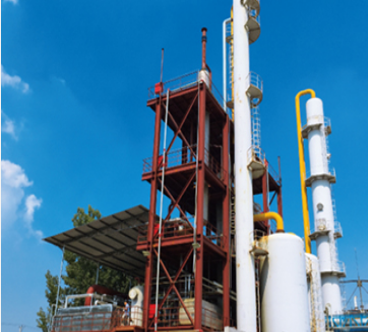預(yù)防濕法脫硫煙氣帶水的措施
Measures to prevent water entrainment in wet FGD flue gas
1��、保證除霧器效果
1. Ensure the effect of demister
主要保證除霧器的沖洗效果���,有以下幾方面:
It mainly ensures the flushing effect of the demister in the following aspects:
(1)控制除霧器沖洗水壓力和流量,建議在脫硫設(shè)備停運時�����,打開人孔門��,逐個沖洗閥門進行調(diào)整�����。通過不斷調(diào)控除霧器沖洗水流量和壓力,確保滿足除霧器沖洗質(zhì)量要求����。并且加強巡檢力度,對沖洗水量和壓力進行監(jiān)測�,發(fā)現(xiàn)異常情況及時采取措施。
(1) Control the flushing water pressure and flow of the demister. It is recommended to open the manhole door and adjust the flushing valves one by one when the desulfurization equipment is shut down. By continuously regulating the flushing water flow and pressure of the demister, it is ensured to meet the flushing quality requirements of the demister. And strengthen patrol inspection, monitor the flushing water volume and pressure, and take measures in time in case of abnormalities.
(2)根據(jù)脫硫系統(tǒng)運行工況����,可適當(dāng)改變除霧器沖洗水間隔時間,保證除霧器沖洗效果����。
(2) According to the operating conditions of the desulfurization system, the flushing water interval of the demister can be appropriately changed to ensure the flushing effect of the demister.
(3)實際運行過程中,建議實時監(jiān)控除霧器上下壓差變化����,確保除霧器和脫硫設(shè)備的良好運行。
(3) During the actual operation, it is recommended to monitor the change of the upper and lower pressure difference of the demister in real time to ensure the good operation of the demister and desulfurization equipment.

2����、提高凈煙氣溫度
2. Increase net flue gas temperature
濕法脫硫后的煙氣溫度一般只有 45~60℃,達到了濕飽和狀態(tài)���。在煙氣排放過程中�����,隨著溫度的降低��,煙氣中的水蒸氣將凝結(jié)成霧�。利用各種煙氣加熱設(shè)備將煙氣加熱到70~80℃�����,可避免水蒸氣的凝結(jié)�,減少煙囪周圍的煙氣帶水現(xiàn)象。目前已有的煙氣加熱技術(shù)有下述幾種:直接燃燒再熱法�;利用冷卻塔循環(huán)水余熱再加熱;用高溫燃燒氣與低溫?zé)煔饣旌?���;用換熱器再加熱等方法。比較可行的方法是用鍋爐二次風(fēng)直接加熱凈煙氣����。
The flue gas temperature after wet desulfurization is generally only 45 ~ 60 ℃, reaching wet saturation. In the process of flue gas emission, with the decrease of temperature, the water vapor in the flue gas will condense into fog. Heating the flue gas to 70 ~ 80 ℃ by various flue gas heating equipment can avoid the condensation of water vapor and reduce the phenomenon of flue gas with water around the chimney. At present, there are several existing flue gas heating technologies: direct combustion reheat method; Reheat with the waste heat of circulating water of cooling tower; Mix high-temperature combustion gas with low-temperature flue gas; Reheat with heat exchanger. The more feasible method is to directly heat the net flue gas with the secondary air of the boiler.
3、控制漿液pH值
3. Control the pH value of slurry
石灰石漿液理想的pH值是在5.5-5.7之間�。當(dāng)煙氣中硫含量改變較大時,建議及時調(diào)控石灰石含漿量�����,避免pH值超標(biāo)。投入過多的石灰石漿液����,不但脫硫效率沒有明顯提高,漿液中硫酸鹽和亞硫酸鹽濃度過飽和��,會加重堵塞現(xiàn)象�����。因此�����,吸收塔pH值要精細(xì)化控制����,保證脫硫系統(tǒng)正常運行,以期在日常工作中防疫隱患發(fā)生�����。
The ideal pH value of limestone slurry is between 5.5-5.7. When the sulfur content in flue gas changes greatly, it is recommended to timely adjust the slurry content of limestone to avoid exceeding the pH value. If too much limestone slurry is added, not only the desulfurization efficiency is not significantly improved, but also the concentration of sulfate and sulfite in the slurry is supersaturated, which will aggravate the blockage phenomenon. Therefore, the pH value of the absorption tower should be finely controlled to ensure the normal operation of the desulfurization system, so as to prevent potential epidemic hazards in daily work.
4��、控制液氣比
4. Control liquid gas ratio
液氣比是指單位時間內(nèi)吸收塔漿液循環(huán)量與吸收塔進口煙氣量的體積比,足夠的液氣比是保證脫硫效率的前提�����,但液氣比偏高會使煙氣帶水量增多���。吸收塔的液氣比一般控制在13~18 L/m3為宜���。因此在滿足脫硫效率的前提下�,液氣比越小越好。對于煙氣流速��,當(dāng)機組帶大負(fù)荷時���,適當(dāng)減少風(fēng)量�����,控制爐膛負(fù)壓和提升風(fēng)機壓力����,降低煙氣流量與流速�,控制煙囪出口煙氣流速低于18 m/s�,可減少煙氣對液滴的攜帶量���。
Liquid gas ratio refers to the volume ratio between the slurry circulation volume of the absorption tower and the flue gas volume at the inlet of the absorption tower in unit time. Sufficient liquid gas ratio is the premise to ensure the desulfurization efficiency, but the high liquid gas ratio will increase the water carrying capacity of flue gas. The liquid gas ratio of the absorption tower is generally controlled at 13 ~ 18 L / m3. Therefore, on the premise of meeting the desulfurization efficiency, the smaller the liquid gas ratio, the better. For the flue gas flow rate, when the unit is under heavy load, appropriately reduce the air volume, control the furnace negative pressure and lift the fan pressure, reduce the flue gas flow and flow rate, and control the flue gas flow rate at the chimney outlet to be less than 18 m / s, which can reduce the carrying amount of liquid droplets by flue gas.
綜上���,濕法脫硫煙氣帶水的形成原因是多方面的,主要有除霧器效率不高�、凈煙氣溫度、煙囪結(jié)構(gòu)不合理和環(huán)境氣象條件���。其中除霧器效率是主要形成原因�,環(huán)境氣象條件是外部原因�。煙氣帶水會造成石膏雨,對環(huán)境造成一定影響���,所以了解煙氣帶水的形成原因���,就可以根據(jù)此方面來預(yù)防。
In conclusion, there are many reasons for the formation of water in wet desulfurization flue gas, mainly including low efficiency of demister, net flue gas temperature, unreasonable chimney structure and environmental meteorological conditions. The efficiency of demister is the main reason, and the environmental meteorological conditions are the external reasons. Water in flue gas will cause gypsum rain and have a certain impact on the environment. Therefore, understanding the causes of water in flue gas can be prevented according to this aspect.
